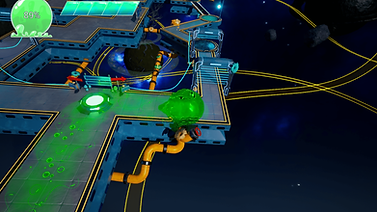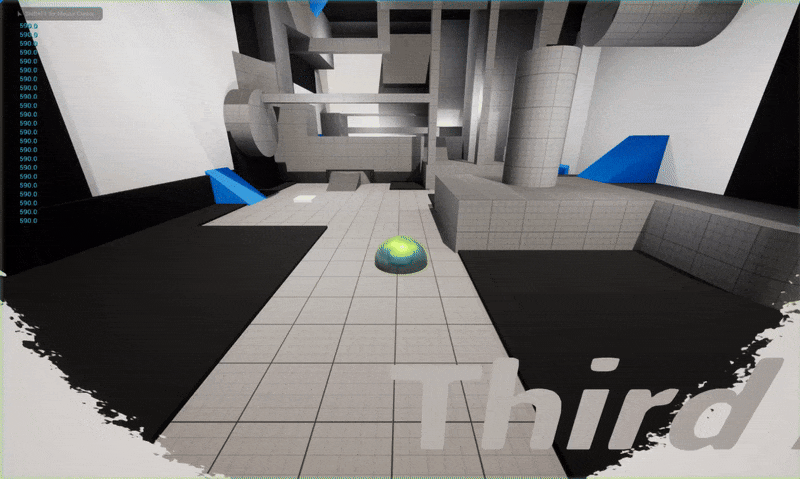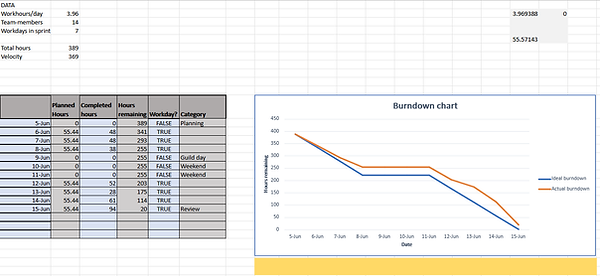
Galactic Goo is a puzzle platformer where you play as a little ball of goo trying to collect broken ship parts in order to continue its galactic journey.

ROLE
Game Designer / Technical Designer
GENRE: Puzzle-Platformer
TEAM SIZE: 14
[5 designers, 6 artists, 3 programmers]
PROJECT DURATION: ~8 weeks
ENGINE: Unreal Engine 5
PLATFORM: Itch.io
The Game
My Role And Responsibilities.
The goal of this project was to create a game based on a reference title using the visual tags: Slime and Circulatory system, with our reference game being Mercury Meltdown.
As this was the first large team project of the study, we did not really have any specific roles or expertise assigned, aside from Level Designer or Technical Designer, I decided to fit myself in the Technical Designer category and worked on a bunch of different features, all focusing around our reference game and the core pillars:
Methodical:
We want the player to be methodical in the way they navigate the environment and puzzles, they should think about their path to the goal carefully.
Dexterous:
We want the level navigation to be challenging as part of the platforming aspect of the game, while also making sure it is not frustrating.
Rolling Momentum:
We want the character to feel like a ball, using rolling and momentum to tie into the previous two points.
The features I developed were the following:
1. Designed, prototyped and iterated upon the player character, camera and controls.
In order to achieve our intended player experience of controlling a rolling object in a methodical and dexterous manner I designed a custom character movement system, as well as manipulate the camera and controls to mimic tilting a platform.
2. Designed and integrated player splitting.
I collaborated with programmers to implement a system allowing the player to split into multiple parts.
3. Designed and implemented various features to support level design and puzzles.
As part of our genre, several puzzling elements needed to be developed in order to create interesting puzzles for the player to solve.
4. Created cinematic level intro sequences.
In order to showcase the players goal per level, as well as giving them a quick overview of the challenges within the level to give them a bit more time to plan ahead,
Additional Contributions:
Since we had no dedicated producer, designers shared production tasks. I contributed to this by:
-
Tracking sprint velocity and maintaining burn-down charts.
-
Hosted SCRUM practices for one sprint.
-
Organized project folder structure and naming conventions.
-
Fixed various bugs and facilitated multiple playtesting sessions.
Methodical:
In Galactic Goo, you control a ball of Goo rolling around intergalactic levels and platforms trying to reach parts of your broken spaceship. The player must be methodical, slowing down to figure out the best route and figure out how to solve puzzles, as rushing around will lead to falling off the edge.
Dexterous:
Players must be strategic and careful, avoiding hazards or slipping off the edge.
Rolling Momentum:
The character feels slippery with an intentional slightly cumbersome control scheme to enhance the rolling feel of the character.



Designed, Prototyped And Iterated Upon The Player Character, Camera and Controls.
To create a methodical and dexterous rolling experience, I collaborated with another designer and our programmers to develop a custom movement system, camera, and controls.
After researching Mercury Meltdown and Super Monkey Ball, we decided to tilt the camera instead of the platform, This approach helped us avoid performance issues while still maintaining the illusion of platform tilting, addressing concerns raised by previous teams who faced performance issues when rotating an entire level.
I prototyped the character with Unreal Engine’s movement system, adjusting friction, acceleration, and deceleration to create a satisfying rolling feel, and implemented early camera tilting. Our programmers refined these with a custom movement component that shifted gravity based on input and a more refined camera system. Through playtesting, we iterated on the system, including reducing camera tilt limits to prevent motion sickness.
The result was a fluid character, camera, and control system that captured the intended rolling momentum and allowed for precise, engaging navigation.


Initial Prototype
Final character, camera and controls
Designed And Integrated The Player Splitting.
The core mechanic of Mercury Meltdown that stood out to us was the blob splitting, which affected both puzzle-solving (color matching) and movement (lighter blobs move faster but are harder to control).
I took on the task of adapting this feature while keeping the scope manageable. Instead of fully replicating it, I analyzed its core design; the strategic choice of when to split or merge, affecting both puzzle interactions and movement.
I designed a system where players could spawn "Blobbles"-small parts of themselves-reducing their mass and altering movement speed, acceleration, and control. Blobbles could activate switches and interact with level elements like treadmills and fans, adding puzzle depth. Players could also split off Blobbles to gain speed, introducing a risk-reward element to navigation.
This mechanic reinforced our intended player experience, encouraging methodical, dexterous movement and improving puzzles and level design.
Splitting speed changes and level interaction

Splitting Design
Designed And Implemented Various Features Supporting Level Design And Puzzles
To support puzzle design and enhance player movement, I designed and implemented several level elements:
Rocket Parts & Optional Pickups
To guide players through levels and provide optional challenges, rocket parts are used as main objectives and gems are used as optional pickups. Initially, I proposed multiple mandatory rocket parts per level, but in the end as a team we opted for a more flexible approach to accommodate different playstyles. Inspired by our reference game, gems were placed in challenging sections or behind puzzles, unlocking slime color customization as a reward.
Moving Platforms & Cable Cars
To encourage methodical movement, I implemented moving platforms, which could be always active or toggleable via switches. I also designed cable cars that required a minimum player mass to activate, however, they were cut due to redundancy and harsh fail states. Both elements used modular, instance-editable target points, making them easy for level designers to integrate.
Additional Contributions
I also assisted with fan animations, an advanced (scrapped) blobble-exclusive switch, and ensuring all level elements interacted properly with both the player and blobbles
Pick-Ups
Initial design intent
![TEAM Centipede (Fe3.026) - Rocket Ship Pieces - Feature Spec [Ruben].jpg](https://static.wixstatic.com/media/1868ed_bb167a1ac672465f87cde5e5c918ba7c~mv2.jpg/v1/fill/w_411,h_338,al_c,q_80,usm_0.66_1.00_0.01,enc_avif,quality_auto/TEAM%20Centipede%20(Fe3_026)%20-%20Rocket%20Ship%20Pieces%20-%20Feature%20Spec%20%5BRuben%5D.jpg)
Cable car
Moving Platforms
Created Cinematic Level Intro Sequences
To help players understand their goals and plan ahead, I implemented cinematic intro sequences at the start of each level.
These sequences begin at the player's start, travel to the ship part (the goal), and zoom in on it for clarity.
Since I was new to Unreal's cinematic sequencer, I researched how to use it and later successfully applied it across all levels with minimal difficulty.
The sequences provided players with a quick overview of the level layout and their objective, helping them prepare and strategize effectively.
Intro Sequence example
Production Work
We did not have a producer for this project, we resolved this by having all the designers take on parts of the responsibilities of a producer, I personally:
-
Tracked sprint velocity and maintained burn-down charts.
-
Hosted SCRUM practices for one sprint.
-
Organized project folder structure and naming conventions.
-
Fixed various bugs and facilitated multiple playtesting sessions.

Burndown Chart Example